Our summer family holiday this year was yet another in the long line of holidays going to the far flung corners of this country. This time it was to the Isle of Mull as we have always liked the rugged beauty of the west coast of Scotland. We'd booked a cottage right by the sea at a location called Grasspoint which is a point on the south east corner of the island looking out across the Sound of Mull back towards the mainland.
As usual we broke up the long journey north by stopping off in the Lake District to stay with relatives and we decided this year to go a day early and actually to spend a day in the Lakes. It was rather late in the year to see the ospreys at Bassenthwaite as they'd already flown the nest and could be anywhere on the lake and surrounding area but on a family walk through the pine forests up to the upper viewing point we were lucky to find one of the birds back on the nest, presumably a juvenile waiting to be fed. I managed a distant digiscoped photo.
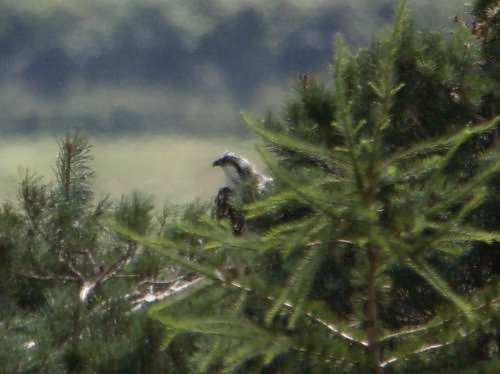
Osprey at view point at Bassenthwaite Lake, Cumbria
I did manage one other evening walk up to the lower viewpoint where the nest is not actually visible but there is a partial view of the Lake. From here there were lots of stock doves flying over and coal tits, greenfinches and chaffinches visiting the feeders. I also saw a distant peregrine fly over the lake being mobbed by a lapwing. A red squirrel, a speciality of the area, was also seen near the feeders.
The journey up to the Isle of Mull was largely uneventful though on the ferry I did manage to see a few black guillemots which are know to nest at Oban from where the ferry departs. The cottage itself turned out to be functional but rather shabby and a bit damp. However this was more than made up for by its fantastic location overlooking the mouth of Loch Don and out to sea with a small jetty a few yards away. There were large hills in the distance across the Loch and also behind the cottage and several small island out in front of us on the far side of the Loch mouth as well as a distant lighthouse. Within a couple of hours of arriving I'd spotted my first white-tailed sea eagle sitting on a ridge behind us before it flew off out into the Sound of Mull. There were also a pair of knot on one of the islands opposite the house, which apparently are somewhat uncommon passage waders for Mull.
As this was a family rather than a birding holiday I tended to get up before everyone else and just wander around Grasspoint to see what I could find and this worked out rather well. Amongst the resident birds around Grasspoint were three oystercatchers that worked their way along the shore line. A walk along the loch shore would often result in the sightings of common sandpiper and curlew and on one occasion there was a party of 4 ringed plover waiting out the high tide.
Out in the loch itself one could often find a black guillemot or two and on the islands opposite there were shags and cormorants as well as a rather fat seal that spent most of its time asleep. Out in the sound were the usual sea birds including guillemots and razorbills flying in their hurried straight lines low over the water; manx shearwaters skimming gracefully over the waves and kittiwakes with their distinctive "ink-dipped" wing tips.
The surrounding habitat was grass and scrub land and hosted a variety of birds. There were large numbers of meadow pipits around the house and a rock pipit or two would put in an occasional appearance. There was a small grove of trees near the house in which a family of willow warblers and a whitethroat or two seemed to live. Across the grassland hen harriers could often be seen hunting and there was a family of buzzards which we regularly encountered on the drive down to the house. Finches such as linnets, chaffinches, goldfinches and greenfinches would regularly fly overhead or be seen sitting on the wires. One of the highlights for me was a couple of sightings of a twite right by the house. I managed really good close views though unfortunately not for long enough to take a photo. On another occasion there was a whinchat sitting on the fence next to the house.

One of the juvenile willow warblers at Grasspoint

One of the members of the buzzard family on post on road to Grasspoint
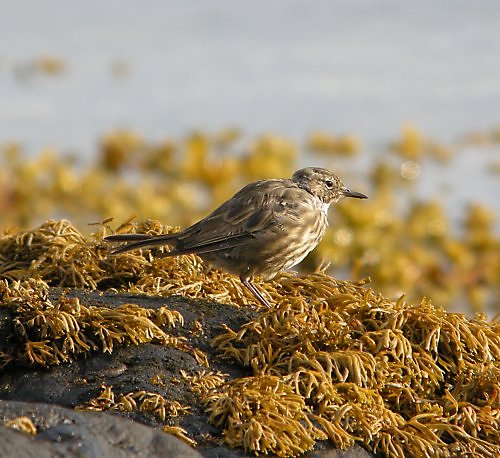
A rock pipit right by the house
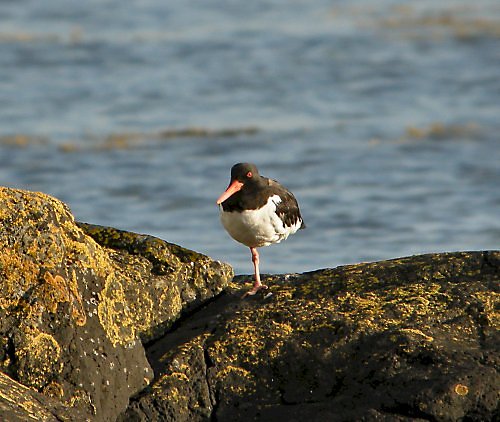
One-legged oystercatcher at Grasspoint

Oystercatcher at Grasspoint
One of the highlights of Grasspoint was the regular sightings of white-tailed sea eagles. They would often sit on the islands on the opposite side of the Loch. In fact several of the island's many wildlife tours would often come down to Grasspoint in order to give the tour goers sightings of the eagles

A White-tailed Sea Eagle drying its wings on one of the islands

A White-tailed Sea Eagle in its favourite perch
As well as a wide variety of bird life there were plenty of mammals to see in the water. I often saw porpoises in the area and once a dolphin as well as the smaller common seal. I once caught a glimpse of what might have been an otter across the estuary though apparently previous house guests had regular sightings close to the house.
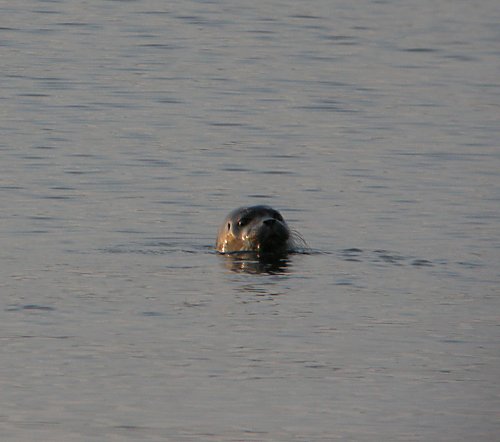
A common seal at Grasspoint
One morning there was a fantastic basking shark swimming really close to the shore just in front of the jetty. I raced around there and managed a digiscoped shot of its huge dorsal fin cutting the water.
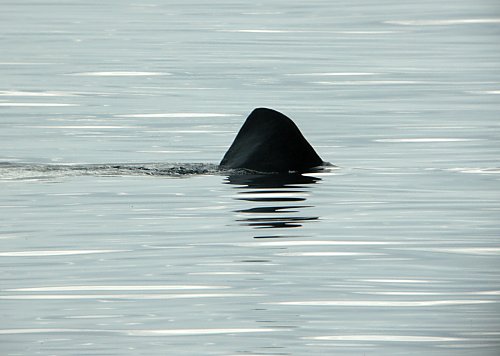
Basking Shark at Grasspoint
Apart from the regular birds there were plenty of occasional sightings to keep me interested. Arctic terns nest on the islands to the west of Mull and they could sometimes be seen hunting out in the Sound of Mull from Grasspoint. On one rather misty occasion I was able to watch for about ten minutes a distant arctic skua harrying all the passing sea birds. On one occasion a red-throated diver was hunting close to the point and I was able to get a reasonable digiscoped record shot of it.
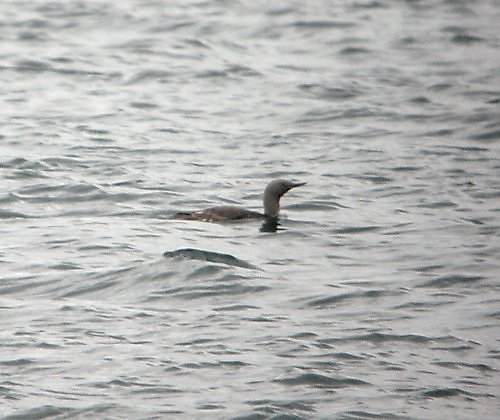
Red-throated diver at Grasspoint
Away from the great birding at Grasspoint, during the day we went on various trips. We were very lucky with the weather and there was only really one day which was too wet to do much other than a drive around the island. On that day we chose a tour along Loch Scridain and Loch na Keal. By the former we were very lucky to get absolutely stunning views of an otter right by the road side on the loch shore. Along the lochs there were typically eider and red-breasted mergansers on the water and wheatears flitting along the shoreline. Grey herons were seen everywhere hunting along the water's edge. I also managed to see a common scoter in Loch Scridain, which apparently isn't that common a visitor to the island.
On a couple of occasions we took the scenic driver down to Loch Buie where the children enjoyed messing about on the beach shore. The first time down there we were lucky enough to spot a pair of huge golden eagles soaring high up in the hills along the roadside. The completely dwarfed the ravens and buzzards that were flying nearby. At Loch Buie itself there were a variety of gulls on the sand at low tide, including lesser and greater black-backed and common gulls. There were also a couple of the subtly-patterned juvenile common gulls present which are always a pleasure to see at this time of year. There were quite a few ravens here and I heard the distinctive trill of a lesser redpoll though couldn't see it. In the water itself were the usual mergansers and eiders and oystercatchers were everywhere along the shore.
One of the most memorable days on the holiday was when we decided to go on a boat trip to Staffa and the Treshnish Islands. The boat was supposed to land on both these islands where there were sea bird colonies including nesting puffins, though it was rather late in the season for them and most would have left by now. Unfortunately the day we chose for this trip it was very windy and indeed the boat skipper warned us that it would be "very choppy out there even by his standards". Foolishly we didn't take the warning and decided to go anyway. It turned out to be far more choppy than anyone had expected and most of us, especially myself were violently ill for most of the journey. It was far too rough to land on any of the islands but we did see Staffa and Fingle's Cave in spectacularly rough conditions. We even managed to see three puffins on the sea as well as a close view of a manx shearwater and a few passing auks and arctic terns. I was so ill though that I had to go to bed for the rest of the afternoon to sleep it off. A most memorable outing!
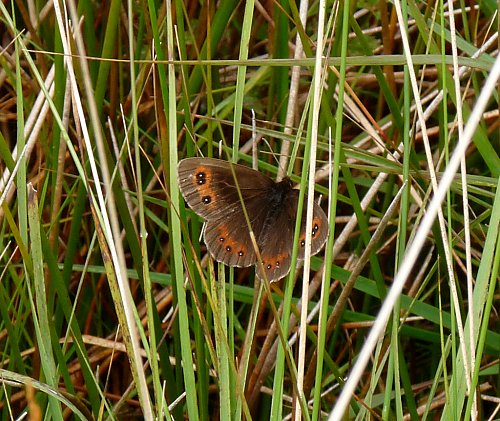
Scotch Argus butterfly: these are not found in England at all but are plentiful on the island
The highlight of the holiday was a visit to the beautiful island of Iona. This involved a drive out through the Ross of Mull to Fionnphort from where the ferry to Iona departed. The scenery was noticably more rugged on this part of the island though with fewer hills. At one point on the journey we saw a large pod of porpoises quite close in to the shore. On the island itself I had been hoping at least to hear a corncrake but it was too late in the season and there were none to be heard. There was a bonus in the form of a great skua soaring high over the monastary where we were having our picnic lunch. After lunch we decided on a walk across to the other side of the island to the poetically named Bay at the Back of the Ocean. It was a beautifully hot day and my younger daughter even got slightly sun-burned. At the bay itself there were about 20 ringed plover, 10 dunlin and a single turnstone feeding along the shoreline. A few eider duck were bobbing about in the water close to the shore. As we headed back a couple of wheatear flitted ahead of us in the grass. We stopped off in a bar for a cup of tea and some cake and sat by the waters edge looking out across the Sound of Iona where a large pod of dolphins and porpoises were leaping and rolling for some time, a wonderful end to a great day.
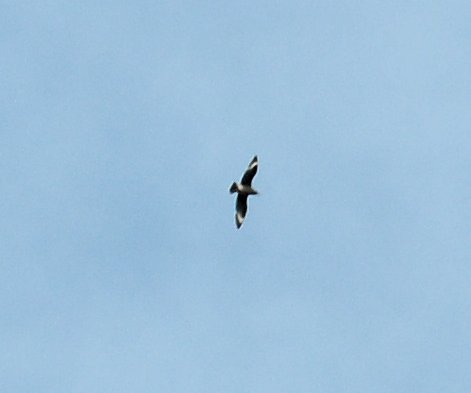
Great Skua soaring over Iona © David Ryan
Sadly the holiday came to an end all too quickly but I was most pleased to have seen such an interesting variety of different birds. Grasspoint turned out to be a wonderful place to stay and fitted in perfectly with the family holiday, offering as it did an opportunity for varied and interesting early morning birding before the rest of the family were awake.

Common Gull at Grasspoint
I was anticipating a few year and life ticks on this holiday but managed more than I was expecting. I was pleased to get both eagles and also the twite (which was a lifer for me) but the two skua were nice bonuses. It was also good to get closer views of puffins albeit under rather challenging circumstances. I would very much like to return to this wonderful part of the country earlier in the season in order to see the puffins nesting and at least to hear a corncrake. As a point of interest, seeing golden eagle means that there are no birds left that I saw only as a boy during the youthful phase of my birding, before the "wilderness years". Effectively I've now seen everything during the two years of "birding phase-two". Not sure how important this is but I thought that I would mention it.
National Year List 2009
210 osprey 01/08/2009 Bassenthwaite, Cumbria
211 white-tailed sea eagle 02/08/2009 Isle of Mull (LIFER)
212 eider 03/08/2009 Isle of Mull
213 twite 04/08/2009 Isle of Mull (LIFER)
214 arctic skua 04/08/2009 Isle of Mull
215 golden eagle 06/08/2009 Isle of Mull
216 great skua 07/08/2009 Iona, Isle of Mull
 The juvenile American Black-tern on the left and the juvenile White-winged Black-tern on the right in this poor quality digiscoped videograb.
The juvenile American Black-tern on the left and the juvenile White-winged Black-tern on the right in this poor quality digiscoped videograb. Kingston Lisle spotted flycatcher
Kingston Lisle spotted flycatcher Juvenile hobby at Bagley Wood
Juvenile hobby at Bagley Wood The confiding juvenile crossbill...
The confiding juvenile crossbill... ...and again even closer up.
...and again even closer up. Osprey at view point at Bassenthwaite Lake, Cumbria
Osprey at view point at Bassenthwaite Lake, Cumbria One of the juvenile willow warblers at Grasspoint
One of the juvenile willow warblers at Grasspoint One of the members of the buzzard family on post on road to Grasspoint
One of the members of the buzzard family on post on road to Grasspoint A rock pipit right by the house
A rock pipit right by the house One-legged oystercatcher at Grasspoint
One-legged oystercatcher at Grasspoint Oystercatcher at Grasspoint
Oystercatcher at Grasspoint A White-tailed Sea Eagle drying its wings on one of the islands
A White-tailed Sea Eagle drying its wings on one of the islands A White-tailed Sea Eagle in its favourite perch
A White-tailed Sea Eagle in its favourite perch A common seal at Grasspoint
A common seal at Grasspoint Basking Shark at Grasspoint
Basking Shark at Grasspoint Red-throated diver at Grasspoint
Red-throated diver at Grasspoint Scotch Argus butterfly: these are not found in England at all but are plentiful on the island
Scotch Argus butterfly: these are not found in England at all but are plentiful on the island Great Skua soaring over Iona © David Ryan
Great Skua soaring over Iona © David Ryan Common Gull at Grasspoint
Common Gull at Grasspoint The adult roseate tern
The adult roseate tern With the juvenile roseate tern out of its box
With the juvenile roseate tern out of its box Feeding avocet
Feeding avocet Avocet in classic pose. Black and white birds are harder to get the autofocus to lock in on so I was pleased that these came out so well.
Avocet in classic pose. Black and white birds are harder to get the autofocus to lock in on so I was pleased that these came out so well. Posing black-tailed godwit
Posing black-tailed godwit A feeding black-tailed godwit
A feeding black-tailed godwit One of the common terns that were nesting in front of the hide.
One of the common terns that were nesting in front of the hide. This bird was perched on this post whilst I was waiting for the return ferry. I just used the camera on its own (no digiscoping) as the bird was only a yard or two away from me. I love the slightly menacing feel to this shot and the interesting perspective of having the bird so close with the house in the background.
This bird was perched on this post whilst I was waiting for the return ferry. I just used the camera on its own (no digiscoping) as the bird was only a yard or two away from me. I love the slightly menacing feel to this shot and the interesting perspective of having the bird so close with the house in the background.